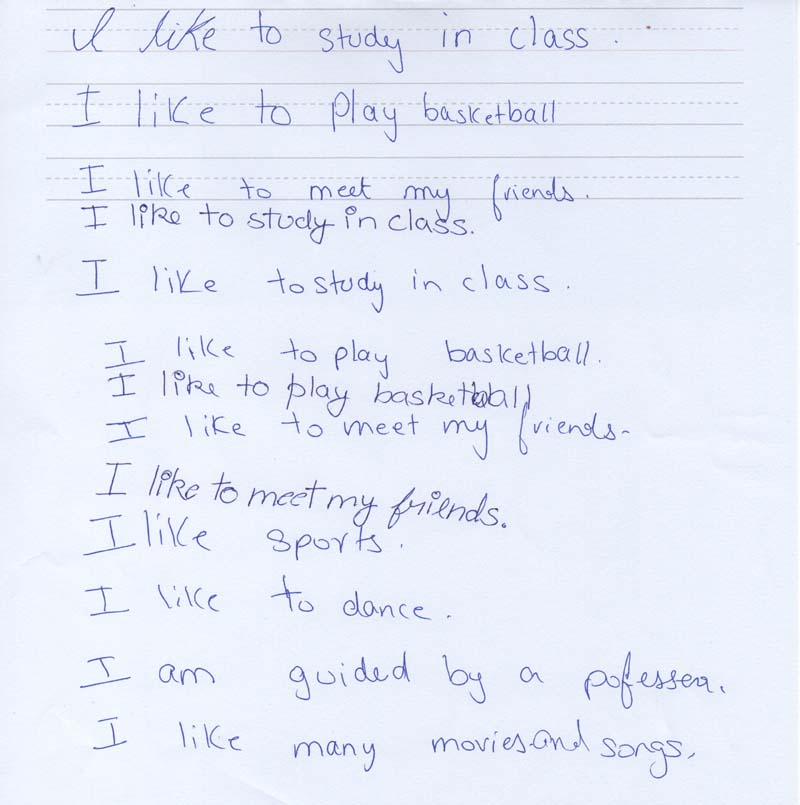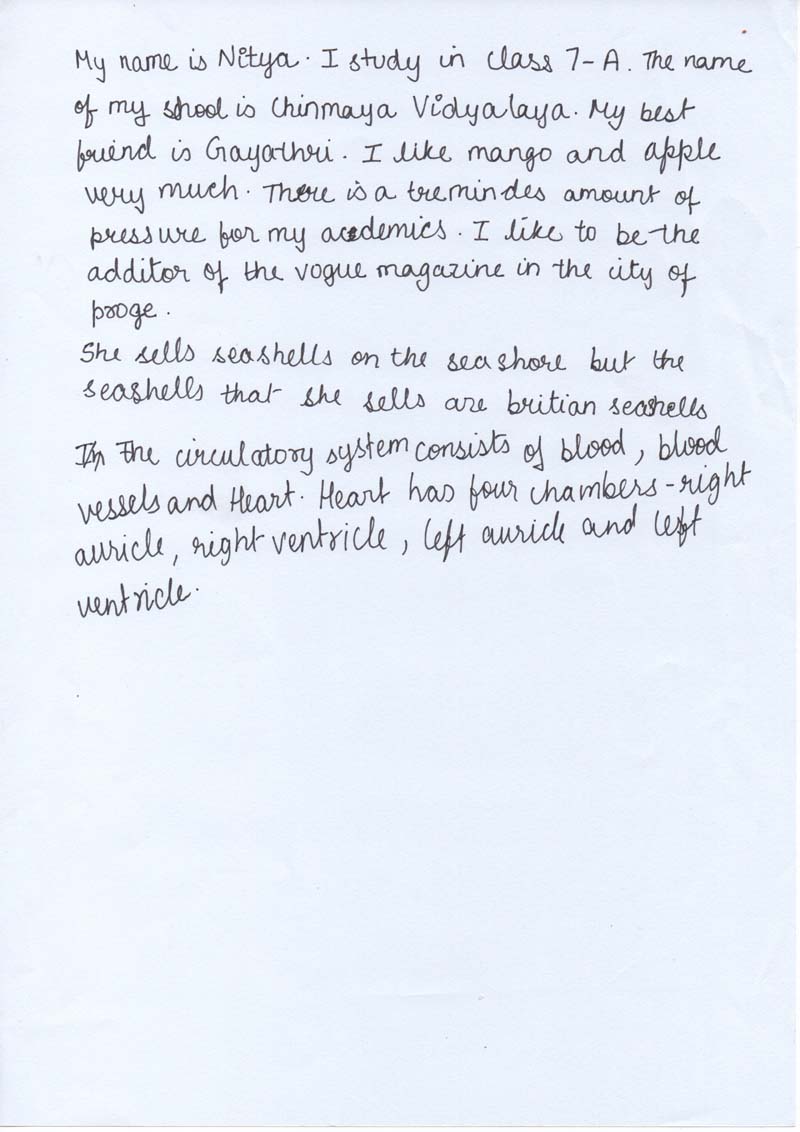Time ( 10AM to 8 PM )
Quest for Legibility
How many children can achieve spatially accurate writing, and at the same time deploy their neurological substrates and recruit them for a muscular initiation derived from their specific motor areas in their brain for writing a sentence – all within milliseconds of a biomechanical context of a perfect smooth spatial signal.
Not many.
There is always a limit to movement precision and absolute consistency. When this movement precision and absolute consistency do not coordinate accurately, we have a ‘handwriting situation’ – words not formed accurately with one letter bigger than the others in a word along with a non-linear output. Additionally there will be strings of varying letters, repetition of arcades and garlands and a large degree of dysfluency in the output.
The following is an example of a proficient writer who is 12 years old and a dysgraphic writer who is 12 years old.


If you observe the samples, you will find that the dysgraphic writer has no spatial concept of target and compliance zones and the letter sizes and inaccuracy in recalling the academic text is evident due to a heavy burden on the childs cognitive system.
The dysgraphic child has a very high load on the inherent muscular initiation programme and there is an absence of the delicate tuning required from the hand as a whole and the fingers in particular, resulting in inaccuracy in the upper and lower zones along the lineation.
The dysgraphic child has made errors on stroke curvature, overshoots, undershoots and the curved letter strokes are inconsistent. If you notice the same or something similar, where your child is concerned, be assured that it will impact his/her overall academic proficiency. Poor psychomotor skills as shown above in the dysgraphic childs handwriting - exist and will persist and this also affects the writing speed and the ballistic movement trajectories.
Dysgraphia may be a long-term persistent trait when left untreated. Treatment is not writing pages upon pages to perfect ‘handwriting’.
Treatment has to be focused and should be based on identifying the actual outcome of the failure of the psychomotor system and aspects of the neuromusculature system, so that a dysgraphic childs ability to develop natural regularity of the trace is enhanced which is within the acceptable limits of good appearance and readability.
This can be achieved by the DAI™ T.R.A.I.N™ programme which targets amongst other issues the spatial variability and its basic neuromotor processes. Our programme improves the capability of distal writing movements and decreases the dysgraphic childs less finely graded movements and the proximal effector system.
It is evolutionarily conventional that the development of writing and reading skills begins in the preschool years and subsequently has a continuous cure of growth through out the school years and possibly even in to adulthood. While we would expect a concomitant development, the co occurrence of disabilities in both the areas is increasing rapidly.
The writing sample below is of a 13-year-old child with a measured I.Q of 121. At first the handwriting appears to be neat, but if we have a closer look, we will begin to pick up errors that have components of a Reading Disability as well as a Writing Disability.
The reading disability is evident in the syntax, the semantics and the ‘inventive spelling’ where as the dysgraphia becomes evident within 30 seconds of commencing to write. The lineation goes all wrong as does the size of the lettering in certain words, the spatial disorientation is evident with the drop in beginning line zones and eventually in 45 seconds the child ‘put down’ the pen and gave up.
Despite a high IQ, this child is not able to write and her ability to communicate her knowledge by producing connected text breaks down very quickly and narrative composition is not even evident. This child does not have a problem with word fluency, recognition or comprehension, but has a problem in activating motor units which are causing her to be dysgraphic along with a complete breakdown of her language ability in orthography and the result is marks in school which are in the 40-50% range.
The brain basis of reciprocal relationships between dysgraphia and a reading disability are very strong and they share similar cognitive processes. So if writing is not good, we don’t expect reading to be much better. If reading is not good, how can any child incorporate an increasing amount of purpose into his/her writing and give meaning to the text for presentation to a teacher or an examiner of a question paper.
Dysgraphia is not just a simple inability to write neatly. It is a complex disorder which shares heterogeneous similarities with reading disabilities and they both combine to create cognitive deficits which are additive and create a overlap where the reading ability of a child is also overshadowed with the poor development of graphomotor skills.
The key issues you need to observe in your child are does he/she demonstrate:
Difficulty with shape-discrimination and letter spacing.
Difficulty and a problem organizing words on the page from left to right
Is writing letters that go in all directions, and forms letters and words that run together on the page
Finds it extremely hard to write on a line and inside margins.
Gets confused when he/she tries reading maps, drawing or reproducing a shape
In the classroom the teacher complains that the child copies text slowly
Has trouble holding a pencil correctly, tracing, tying shoes and doing puzzles.
Is unable to use scissors well or to color inside the lines such that half the crayon colour is outside the template provided.
Holds his/her wrist, arm, body or paper in an awkward position when writing. That is will turn the paper at a 45Degree angle or more.
When he/she has to write something the child has trouble getting ideas down on paper quickly.
Demonstrates trouble understanding the rules of games.
Has a hard time following directions given by you and ‘just forgets’ the sequence.
Loses his/her train of thought.
Is still making spelling mistakes and has a hard time understanding spelling rules.
Finds it difficult to locate or tell if a word is misspelled.
Can spell correctly orally but makes spelling errors in writing.
You notice that in the same chapter the child spells words incorrectly and in many different ways.
Mixes upper- and lowercase letters.
While writing it is a blend of printing and cursive.
Writes down something and then has trouble reading. his/her own writing.
Avoids writing as much as he/she can.
Complains that his/her hand gets tired or cramped.
The books have a lot of erasing on them.
Just does not know how to use punctuation.
There is an overuse of commas or there are no commas and mixes up verb tenses.
Sentences do not start with a capital letter.
Finds it difficult to write in complete sentences but writes in a list format.
When asked to write he/she writes sentences that -run on forever.
When telling a story and may start in the middle and then leaves out important facts and details, or provides too much information which is repetitive.
Assumes others know what he/she is talking about.
Uses vague descriptions when asked to explain what has been read.
Sentences are all jumbled up.
Finds it difficult to get to the point, or makes the same point over and over
Is better at conveying ideas when speaking
Preschool children may be hesitant to write and draw and say that they hate coloring.
School-age children may have illegible handwriting that can be mix of cursive and print. They may have trouble writing on a line and may print letters that are uneven in size and height. Some children also may need to say words out loud when writing or have trouble putting their thoughts on paper.
Teenagers may write in simple sentences. Their writing may have many more grammatical mistakes than the writing of other kids their age.
If any of these are present in your child, we believe your child needs help. Simply repeatedly ‘advising’ then that they need to be more careful or that they need to ‘practice’ more is not the solution. Children do not commit errors on their own and definitely not on purpose.
When a child is not able to produce a legible trace it is not being done because the child is ‘lazy’ or ‘uninterested’ or as parents say in India ‘is not focused’. It is occurring, because there is a biological basis to the representation you are witnessing as poor handwriting and it needs professional help.
For further information and to book an assessment please contact the Dyslexia Association of India™ on our mobile number 88260 22886 or e-mail us at info@dyslexiaindia.org.in for more advice and information.
(Views and observations expressed in our articles are equivocal and personal based on our observations and experience. Being equivocal and personal they are non contestable and Individuals are under no pressure to confirm to our views, thoughts and observations. The accuracy ratio for screening and remedial processes of the DAI™ is extremely high.)
